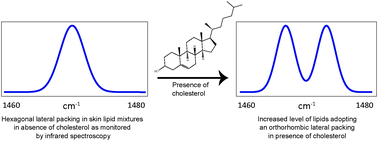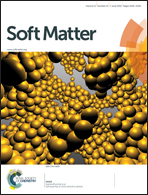Phase behavior of skin lipid mixtures: the effect of cholesterol on lipid organization†
Abstract
The lipid matrix in the stratum corneum (SC), the upper layer of the skin, plays a critical role in the skin barrier. The matrix consists of ceramides (CERs), cholesterol (CHOL) and free fatty acids (FFAs). In human SC, these lipids form two coexisting crystalline lamellar phases with periodicities of approximately 6 and 13 nm. In the studies reported here, we investigated the effect of CHOL on lipid organization in each of these lamellar phases separately. For this purpose, we used lipid model mixtures. Our studies revealed that CHOL is imperative for the formation of each of the lamellar phases. At low CHOL levels, the formation of the lamellar phases was dramatically changed: a minimum 0.2 CHOL level in the CER/CHOL/FFA (1 : 0.2 : 1) mixture is required for the formation of each of the lamellar phases. Furthermore, CHOL enhances the formation of the highly dense orthorhombic lateral packing. The gradual increment of CHOL increases the fraction of lipids forming the very dense orthorhombic lateral packing. Therefore, these studies demonstrate that CHOL is an indispensable component of the SC lipid matrix and is of fundamental importance for appropriate dense lipid organization and thus important for the skin barrier function.


 Please wait while we load your content...
Please wait while we load your content...